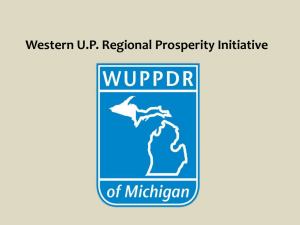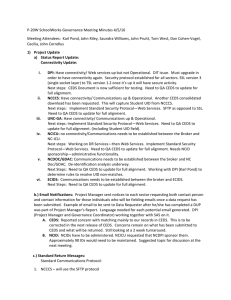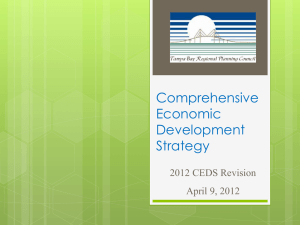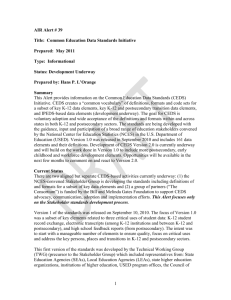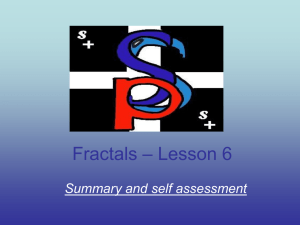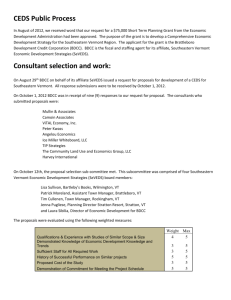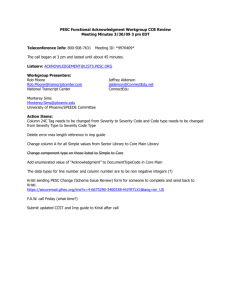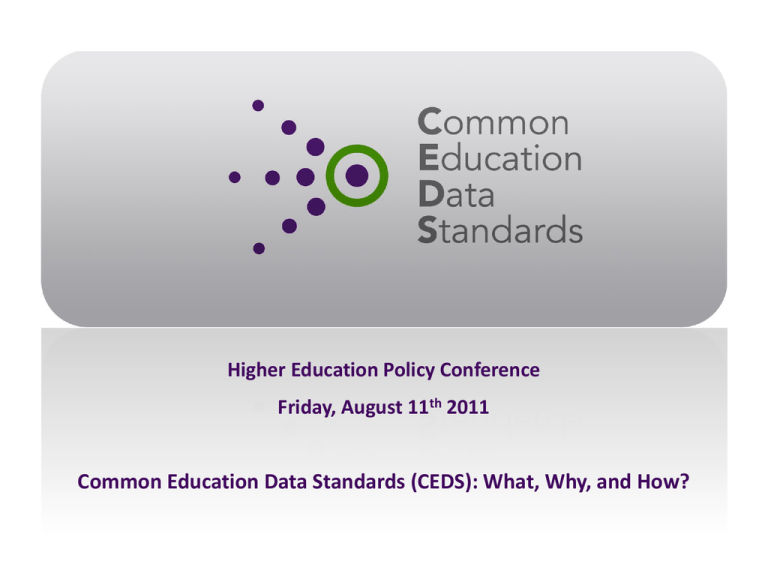
Higher Education Policy Conference
Friday, August 11th 2011
Common Education Data Standards (CEDS): What, Why, and How?
Today’s Panelists
Panel Members:
o Shawn T. Bay, Founder, eScholar LLC
o John Blegen, Project Manager, Common Education Data
Standards, SHEEO
o Brandt Redd, Senior Technology Officer, Bill & Melinda Gates
Foundation
o Gary West, Strategic Initiative Director for Information Systems
and Research, Council of Chief State School Officers
Moderator:
o Katie Zaback, Policy Analyst, SHEEO
2
WHAT IS THE COMMON EDUCATION DATA
STANDARDS INITIATIVE?
3
Why Do We Need Common Data
Standards?
Educators and policy makers need accurate, timely, and
consistent information about students and schools in order to
plan effective learning experiences, improve schools, and
reduce costs.
In addition, our student population is highly mobile – across
districts and states, and between K-12 and postsecondary –
thus the need to share high quality data requires that we
develop a common vocabulary for a core subset of data
elements that exist in multiple data systems.
4
What are the standards?
A national collaborative effort to develop voluntary, common
data standards for a key set of variables.
CEDS elements focus on standard definitions, code sets, and
technical specifications of a subset of key data elements. This
will increase data interoperability, portability, and
comparability across states, districts, and higher education
organizations.
Voluntary Common Vocabulary
5
CEDS Stakeholders
Local Education Agencies
State Education Agencies
Institutions of Higher Education (public and private)
State Higher Education Agencies
SHEEO and CCSSO
Interoperability Standards Org: PESC and SIF
USDOE Program Offices: NCES, OPEPD, OET, OUS, OPE, and FSA
Associations: AACC, APLU, AIR, NAICU
Foundations: Gates and MSDF
Other Federal: DOL (invited)
6
Why is NCES involved?
Data quality is essential to their mission. They believe that data
quality begins at the institution level.
Common education data standards not only facilitate data
exchanges between institutions, states, and the federal
government but it also helps improve data quality from the
ground up both when reporting to NCES (e.g., IPEDS) and in
the SLDS-funded state systems.
7
Status and Timeline
Version 1
Released in September, 2010
161 elements – focused on K-12
• Student record exchange across districts/States
• Student transcripts
• High school feedback reports from postsecondary to K-12
Version 2.0
Overall, focus will be more on postsecondary for Version 2.0
Postsecondary different from K12
• Most institutions are private (even though most enrollments are in publics)
• Not all institutions in state systems
• Different state governance and systems
What binds them all together?
8
Why IPEDS?
Good for state systems
• Applies to all Title IV institutions regardless of whether in a state data system, but state systems could still
adopt them and assist with data-sharing across institutions in their system (as well as with IPEDS reporting)
• IPEDS covers topics of most interest: enrollments, transfers, completions (i.e., student mobility)
Good for institutions
• NCES can use CEDS to build new tools to assist with data reporting and help ease reporting burden
• Institutions can share data, when appropriate, using a common language
Good for project plan
• Provides an achievable scope of work for Version 2.0; IPEDS is ultimately a Use Case for CEDS but also keeps
work directed and manageable
Good for aggregated data quality
• NCES is always interested in improving data quality and comparability in its data collections
• IPEDS training can provide more details to data providers and base it on CEDS, ultimately improving data
quality
9
CEDS Consortium
Advocacy
Communication
Adoption
Implementation
CCSSO 1
SHEEO 1
The Managing Partners
1
2
10
Bill and Melinda Gates Foundation
Michael and Susan Dell Foundation
DQC 2
PESC
SIF
FROM OUR PANELISTS
11
Personalized Learning Model
“What don’t I
know?”
Learning
Feedback
Loop
Student Data
Alignment
Alignment
Learning Alignment
Objectives
“How did
I do?”
“How do I
learn this?”
Assessment
Content
Four-Layer Framework
for Data Standards
Data
Dictionary
Definition of data Elements
including Name and
Interpretation.
Data
Model
Logical definition of Entities
as groups of elements and
inter-entity Relationships.
Serialization
Concrete digital format for
storage or interchange of
Elements.
Protocol
Format and rules for
exchanging Serialized
Elements
Ease of Data Exchange and
Systems Integration
Broader Applicability and
Longevity of Standards
CEDS 2.0
Copyright eScholar LLC ©2010. All Rights Reserved.
Interstate Use Case
The eScholar Interstate project is
designed for states to search for students
across state borders. The goal is provide
the states an ability to find potential false
dropouts and more effectively manage
student records.
Copyright eScholar LLC ©2010. All Rights Reserved.
Interstate Data Mapping
Data Mapping for Interstate Project
Interstate Field
PESC Field
State Student ID
AgencyAssignedId
IMS Field
sourcedid
SIF Field
StateProvinceID
Student First Name
Student Last Name
Student Middle Name
Student Name Suffix
Previous Last Name
name/n/given
name/family
name/partname/partnametype
name/n/suffix
name/partname/partnametype
FirstName
LastName
MiddleName
N/A
Name Type ="05"
FirstName
LastName
MiddleName
NameSuffix
N/A
CEDS Field
StudentIdentificationCode
StudentIdentificationSystem="State"
FirstName
LastName
MiddleName
NameSuffix
OtherName
Name Type valid value
05 Previous Name
(sometimes called Maiden
Name of Female Persons)
Date of Birth
Gender
Grade Level
BirthDate
GenderCode
StudentLevelCode
bday
gender
grouptype/typevalue/level
BirthDate
Gender
GradeLevel/Code
Birthdate
Sex
EntryGrade Level
Race Ethnic Code
Ethnicity Indicator
Social Security Number
RaceCode
EthnicityCode
SSN
N/A
N/A
sourcedid
RaceList/Race/Code
HispanicLatino
SSN
Race
Hispanic LatinoEthnicity
StudentIdentificationCode
StudentIdentificationSystem="SSN”
Local Student ID
SchoolAssignedPersonID
sourcedid
LocalID
StudentIdentificationCode
StudentIdentificationSystem="District"
Country of Birth
Source System Code
Last Update Date
Entry Date
Entry Code
Exit Date
Exit Code
Entry Type
BirthCountry
N/A
CreateDateTime
Entry Date
N/A
ExitDate
Exit Reason Code
N/A
N/A
datasource
datetime
timeframe/begin
N/A
timeframe/end
N/A
N/A
CountryOfBirth
N/A
N/A
EntryDate
EntryType/Code
ExitDate
ExitType/Code
N/A
BirthCountry
N/A
N/A
EntryDate
EntryType
ExitWithdrawalDate
ExitWithdrawalType
N/A
Copyright eScholar LLC ©2010. All Rights Reserved.
How to Converge the standards
1.
2.
3.
4.
5.
6.
7.
Create an over-arching standards convergence initiative (CEDS).
Set up open groups that address (data elements, data content rules, communication standards, IP
and licensing.
Invite leadership from existing standards organizations to participate in groups (SIF, PESC, IMS,
etc.)
Get the customers (SEAs and LEAs) onboard and committed to the objective that any new
functionality delivered that involves interoperability of data will conform to the current version of
the overall standard.
Make it clear that the scope is as broad as the educational customers need it to be. (P-20, WF,
Instructional, etc).
Set short deadlines for approved versions
Have the customers drive vendor participation and compliance.
Naming and
Identification
SIF
Data Content
Rules
SIF
PESC
PESC
IMS
NCES
CEDS/TSDS
CEDS/TSDS
Messaging/
Communication
Standards
IP and Licensing
SIF
SIF
PESC
PESC
IMS
IMS
CEDS/TSDS
CEDS/TSDS
Copyright eScholar LLC ©2010. All Rights Reserved.
CCSSO Goals for State Information Systems
• States support comprehensive information systems that address the states’ data
needs:
• Inform teaching and learning (inform what should happen next for each
learner)
• Automate all federal reporting (in the aggregate from record-level source data)
• Support the newly proposed accountability principles (state-based reporting)
• Share data with constituencies and communities (automate SchoolDataDirect
and SchoolMatters, others)
Student
Success
High Quality
Instruction &
Leadership
Core Teaching
Standards
Growth
Opportunities
& Supports
Educator &
System
Accountability
Professional
Development
Standards
Data
Standards
Common Core
State
Standards for
Students
School Leader
Standards
Integration of Data through the States’ SLDS and ETL through CEDS 2.0
LMS
(Learning Management System)
Common Core State Standards
Aligned Academic Standards
Curriculum Components
Instructional Planning
SIS
EDS
(Student Information System)
(Educator Data System)
Students
Teachers
Courses
Teachers
Principals
Other Education Staff
Evaluation Data
Credentials/Licenses
Classes/Sections
Instructional Programs
Instructional Materials
Instructional Resources
Discipline/Behavior
Grades/Transcripts
More
Schedules
Professional Development
Schools of Education
Instructional Activities
More
More
SLDS
AMS
(Statewide Longitudinal Data System)
(Assessment Management System)
Common Ed Data Standards
State Core Model
Common Core Assessments
Statewide Assessments
Formative Assessments
Interim Assessments
More
Filters and Queries
De-Identification Systems
Unique Identifiers
Reporting
Research
More
IDS
PDS
(Postsecondary Data Systems)
Educator Preparation
College Readiness
Reporting
Research
More
WDS
(Unique ID/Indexing Systems)
(Workforce Data Systems)
Students
Teachers
Courses
Business Partners
Workforce Readiness
ID Management
Professional Development
Instructional Resources
More
CEDS
2.0
ETL
Workforce Preparation
Armed Forces
Reporting
Research
More
CSEIS
Moving the State’s Data through CEDS 2.0
ETL
State
SLDS
CSEIS
A state’s SLDS data will be extracted by the state’s ETL application
The state’s ETL application will transform the data based on common standards and data model
The transformed data will be loaded into the comprehensive state education information system (CSEIS)
5
21
The
Other
State
Data
State
SLDS
Apps Store
Dashboards
Learning
Learning
Content
Maps
Accountability
Individualized
Principles
Learning Plans
Support
More…
Vender Apps
CRDC
Reporting
ETL
App
CEDS
2.0
CSEIS
Common State
Education Information
System
EDFacts
Reporting
Students are following diverse paths in and out of early
childhood, K-12, postsecondary, & workforce
Full Time Job # 2
Full Time Job # 1
Graduate Degree
Bachelor’s Degree
Apprenticeship
Part Time Job 2
4-Year College
Certificate
Associate Degree
2-Year College
GED
Part Time Job
Training
High School
Diploma
High School
Elementary &
Middle School
Early Childhood
Education
Military Service
A decade later, HEDS began data sharing
among more than 100 Private institutions
Since then,
hundreds of
decentralized,
independent,
data sharing
agreements
continue to
moved the
inquiry process
forward.
But, each project has to solve the data standards problem all over again…
In the Late ‘60s SREB began sharing data among its members!
Every Sector of the Education Community can
benefit from the improved efficiency and
superior data quality that can result from
Common Education Data Standards

